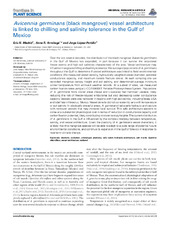| dc.creator | Madrid, Eric N. | |
| dc.creator | Armitage, Anna R. | |
| dc.creator | Lopez-Portillo, Jorge | |
| dc.date.accessioned | 2014-09-29T21:40:22Z | |
| dc.date.available | 2014-09-29T21:40:22Z | |
| dc.date.issued | 2014-09-26 | |
| dc.identifier.citation | Madrid EN, Armitage AR and López-Portillo J (2014) Avicennia germinans (black mangrove) vessel architecture is linked to chilling and salinity tolerance in the Gulf of Mexico. Front. Plant Sci. 5:503. doi: 10.3389/fpls.2014.00503 | en |
| dc.identifier.uri | https://hdl.handle.net/1969.1/152214 | |
| dc.description.abstract | Over the last several decades, the distribution of the black mangrove Avicennia germinans in the Gulf of Mexico has expanded, in part because it can survive the occasional freeze events and high soil salinities characteristic of the area. Vessel architecture may influence mangrove chilling and salinity tolerance. We surveyed populations of A. germinans throughout the Gulf to determine if vessel architecture was linked to field environmental conditions. We measured vessel density, hydraulically weighted vessel diameter, potential conductance capacity, and maximum tensile fracture stress. At each sampling site we recorded mangrove canopy height and soil salinity, and determined average minimum winter temperature from archived weather records. At a subset of sites, we measured carbon fixation rates using a LI-COR 6400XT Portable Photosynthesis System. Populations of A. germinans from cooler areas (Texas and Louisiana) had narrower vessels, likely reducing the risk of freeze-induced embolisms but also decreasing water conductance capacity. Vessels were also narrower in regions with high soil salinity, including Texas, USA and tidal flats in Veracruz, Mexico. Vessel density did not consistently vary with temperature or soil salinity. In abiotically stressful areas, A. germinans had a safe hydraulic architecture with narrower vessels that may increase local survival. This safe architecture appears to come at a substantial physiological cost in terms of reduction in conductance capacity and carbon fixation potential, likely contributing to lower canopy heights. The current distribution of A. germinans in the Gulf is influenced by the complex interplay between temperature, salinity, and vessel architecture. Given the plasticity of A. germinans vessel characters, it is likely that this mangrove species will be able to adapt to a wide range of potential future environmental conditions, and continue its expansion in the Gulf of Mexico in response to near-term climate change. | en |
| dc.description.sponsorship | The open access fee for this work was funded through the Texas A&M University Open Access to Knowledge (OAK) Fund. | en |
| dc.language.iso | en_US | |
| dc.publisher | Frontiers Media | |
| dc.rights | Attribution 3.0 United States | en |
| dc.rights.uri | http://creativecommons.org/licenses/by/3.0/us/ | |
| dc.subject | elasticity | en |
| dc.subject | evolution | en |
| dc.subject | phenotypic plasticity | en |
| dc.subject | safe xylem hydraulic architecture | en |
| dc.subject | salt marsh | en |
| dc.subject | Spartina alterniflora vessel architecture | en |
| dc.subject | wetland | en |
| dc.title | Avicennia germinans (black mangrove) vessel architecture is linked to chilling and salinity tolerance in the Gulf of Mexico | en |
| dc.type | Article | en |
| local.department | Biology | en |
| dc.rights.requestable | false | en |



